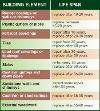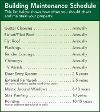Building maintenance - it's your responsibility
Do you own a house, flat, or any part of a building?
South Ayrshire Council is keen to improve public safety, and an important part of this is making property owners aware of their responsibilities.
Inspect their properties regularly to check that they are in a safe condition, and carry out maintenance works as required.
The Council has a responsibility to deal with buildings that are in a dangerous condition, and if necessary to ensure that these buildings are vacated by the occupants. In addition, the Council has powers to take direct action to make buildings safe if the owners are unable to arrange for work to be carried out, with the costs being legally recoverable.
Grant assistance under the Private Sector Housing Grant (PSHG) Scheme may be available for owners of residential properties within designated town centre areas. Applications can be made for essential work such as roof and masonry repairs that need to be carried out in the interests of safety.
10 steps to being a responsible owner and maintaining the value of your property
Step 1: Recognise that you are responsible for your building, If you are a flat owner you will be jointly responsible.
Your exact responsibilities are set out in your Title Deeds and under the Occupiers Liability Act (Scotland) 1960. Recent changes in property law give you more ways to get co-operation from your co-owners if there are problems with the Title Deeds.
Step 2: If you live in a shared building
Talk to your fellow owners and agree who is responsible for what. Some of them may also have useful skills or contacts that you can use in bringing your building back into shape.
Step 3: Get your neighbours organised
Setting up an Owners' Association would be a good idea, as is the appointment of a factor to organise maintenance.
Step 4: Get your building checked regularly
Ideally you should get a building condition survey carried out every five years by an experienced professional such as an architect or surveyor. You should at least carry out a quick survey yourself.
Step 5: Put together a list of past repairs
If you are in a shared building ask your neighbours and check out any surveys carried out in the past. You should try to record what work was done, when, by whom and if there is a guarantee. This is useful information, so keep it safe and up to date and pass the file on to another owner when you move.
Step 6: Check out the typical length of life of common building parts
For example, is your roof past its sell by date? See Building Element Table Below
Step 7: Put together a maintenance plan
This will help you prioritise the 'stitch in time' repairs and help you work out how to save for big repairs. It should include a schedule of inspections and routine maintenance on the building, a list of reliable contractors and arrangements for paying for the work.
Step 8: Sort out how you will pay for repairs
If the cause of the problem is storm, fire or flood you may be able to claim against your buildings insurance. Some people in shared buildings set up joint maintenance funds for common repairs, where each owner pays into the fund and guarantees that if they sell the new owner will take on responsibility for payment.
Step 9: Decide which builder to employ
Consider how you are going to choose a builder suitable for any work which needs done. Small building firms do small jobs well but bigger jobs need bigger firms with the resources for complex work.
Step 10: Plan for future repairs or maintenance
All parts of buildings decay over time so it's best to plan for future repairs and maintenance and not be caught out by emergency repairs which could be expensive.
How long should building parts last?
This is a general guide only based on regularly maintained buildings. You should get a survey carried out at least every 5 years to establish the actual condition.
Did you know that as an owner you are legally responsible for any accidents caused by defects in your building?
Poor building condition can also reduce property values, lead to spiralling repair bills and mean cold or damp living conditions.






